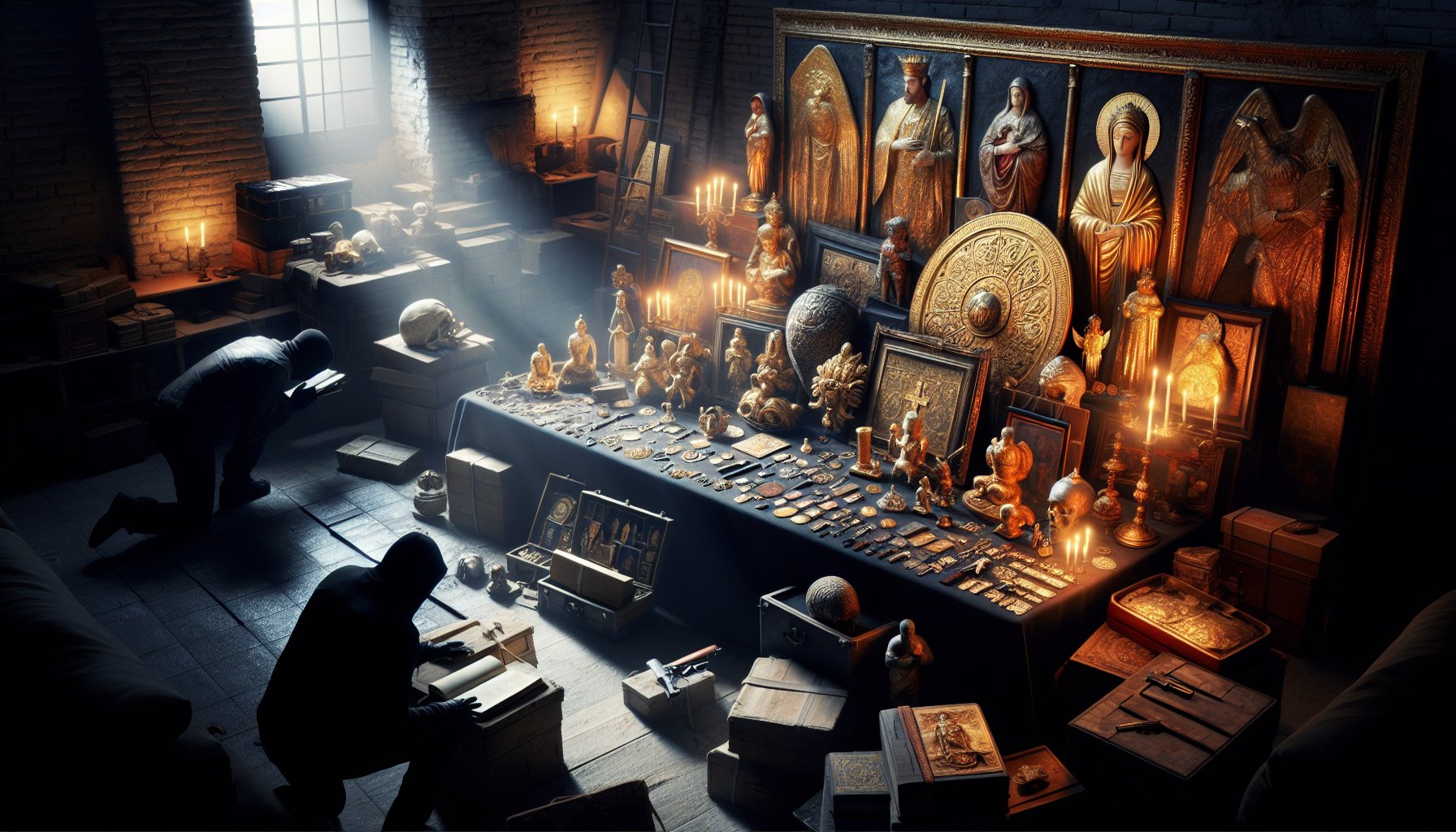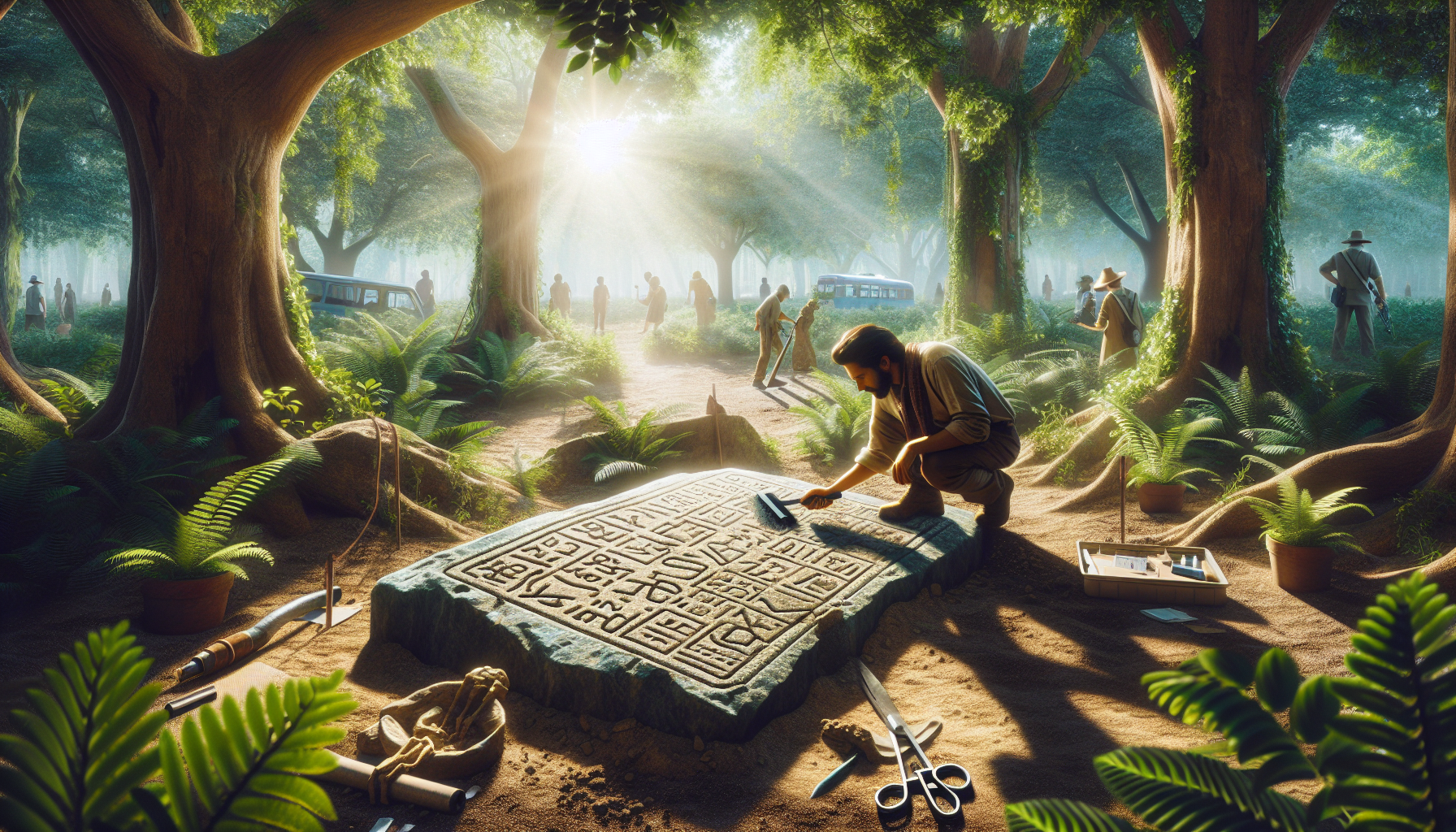In the shadowy corridors of time, where the echoes of forgotten stories whisper through the ages, lie tales of intrigue, deception, and adventure—stories that hinge upon the enigmatic allure of lost treasures. These relics, often born of the hands of skilled artisans and imbued with the spirit of bygone eras, have not only shaped the course of history but also continue to captivate the imagination of those who dare to seek them. As you delve into the mysterious world of stolen relics, prepare to embark on a journey that traverses continents and centuries, uncovering secrets that have eluded even the most astute historians and treasure hunters. 🌍
Throughout history, the human penchant for coveting the rare and valuable has led to audacious heists and daring pursuits. From the gleaming halls of ancient temples to the fortified vaults of modern museums, some of the world’s most famous artifacts have vanished without a trace, slipping through the fingers of their rightful owners. The theft of such relics not only deprives humanity of its cultural heritage but also ignites an insatiable quest to recover what has been lost. What motivates individuals to risk everything for a chance to possess these storied treasures? And what becomes of these relics once they are whisked away into the shadows?
In this exploration of history’s most notorious stolen relics, we will uncover the stories behind some of the world’s most infamous art heists and artifact disappearances. From the mysterious vanishing of the Amber Room—a breathtakingly ornate chamber gifted to Peter the Great—to the persistent legend of the Ark of the Covenant’s hidden resting place, each tale is a testament to human ingenuity, greed, and the relentless pursuit of knowledge. Alongside these narratives, we will delve into the methods employed by modern-day detectives and historians as they strive to unravel these age-old mysteries. 🔍
As we peel back the layers of these intriguing stories, we will also examine the broader implications of artifact theft on culture and society. How do these losses affect our understanding of history? What role do international laws and agreements play in the recovery and repatriation of stolen treasures? And perhaps most importantly, what ethical considerations arise when reclaiming artifacts from those who have safeguarded them for generations? Through these questions, we will navigate the complex interplay between the past and present, exploring how the hunt for stolen relics continues to shape our world today.
Join us on this fascinating odyssey, where the past is never truly lost and every discovery brings us one step closer to understanding the intricate tapestry of human history. Together, we will uncover not just the relics themselves, but the enduring stories they tell—a reminder that even in the face of loss, the spirit of discovery and curiosity lives on. Whether you’re a history enthusiast, a lover of adventure, or simply intrigued by the mysteries of the past, this exploration promises to enlighten and inspire, as we unlock the secrets of history’s most captivating stolen treasures. ✨
The Intriguing World of Stolen Relics
The realm of stolen relics is a fascinating yet somber dimension of human history, filled with tales of adventure, greed, and sometimes justice. These artifacts, often embodying immense historical and cultural value, have traversed the world under dubious circumstances. This clandestine trade has attracted the interest of historians, archaeologists, and treasure hunters alike, each eager to uncover the secrets and rightful ownership of these relics.
Historically, the looting of artifacts dates back to antiquity. During wars, it was common for victors to seize treasures from the conquered lands as symbols of triumph. Such acts were seen during the Roman conquests, where Roman generals would parade their spoils through the streets of Rome. However, as time progressed, the illicit acquisition and sale of these items took a more organized form. This was notably seen during the colonial era, where numerous artifacts were taken from colonized nations and showcased in European museums, often without regard to their cultural significance.
In modern times, the hunt for stolen relics has become an international endeavor. Organizations such as Interpol and UNESCO have established frameworks to combat this illicit trade. Despite these efforts, the black market for stolen artifacts remains lucrative, driven by private collectors willing to pay exorbitant sums for these pieces of history. This ongoing battle between preservationists and looters keeps the narrative of stolen relics alive, with each recovered artifact serving as a testament to the importance of cultural heritage.
The Most Famous Stolen Relics in History
Throughout history, certain stolen relics have captured the public’s imagination, often due to their mysterious disappearances and the legends surrounding them. One of the most famous of these is the Amber Room, a chamber decorated in amber panels, gold leaf, and mirrors, originally located in the Catherine Palace of Tsarskoye Selo near St. Petersburg. The room disappeared during World War II and has since become a symbol of lost treasures.
Another infamous case involves the Koh-i-Noor diamond, which has a tumultuous history of conquest and betrayal. Originally from India, it changed hands multiple times among various rulers before being ceded to Queen Victoria in 1849. The diamond is now part of the British Crown Jewels, but its rightful ownership is still contested by several countries.
The Elgin Marbles, also known as the Parthenon Marbles, have long been a source of international dispute. These classical Greek marble sculptures were removed from the Parthenon by Lord Elgin in the early 19th century and later sold to the British Museum. Greece has since demanded their return, citing cultural and historical injustice.
Understanding the Black Market for Artifacts
The black market for stolen relics is a complex network involving smugglers, intermediaries, and buyers. This shadowy world thrives on secrecy and deception, often masking the origins of artifacts to legitimize their sale. Many stolen relics are moved across borders through false documentation, making it challenging for authorities to trace their provenance.
One critical aspect of the black market is the role of intermediaries, who act as brokers between sellers and buyers. These individuals are skilled at navigating the intricacies of illegal trade, often utilizing encrypted communications and offshore accounts to conduct transactions. The anonymity provided by such methods allows buyers to acquire artifacts without raising suspicions, thereby perpetuating the cycle of theft and sale.
Efforts to curb this illicit trade have been bolstered by technological advancements. Digital databases and blockchain technology are now employed to track artifacts and verify their authenticity. Additionally, increased collaboration between international agencies has resulted in more coordinated efforts to recover stolen items. However, despite these measures, the demand for stolen relics remains high, driven by a combination of cultural fascination and financial speculation.
Challenges in Repatriating Stolen Artifacts
Repatriating stolen relics poses significant challenges, both legally and diplomatically. The process often involves complex negotiations between countries, each with their own legal frameworks and cultural policies. One prominent example is the ongoing dispute over the Benin Bronzes, a collection of sculptures taken from the Kingdom of Benin (now Nigeria) during a British punitive expedition in 1897. These artifacts are scattered across various museums worldwide, and efforts to return them to Nigeria have been met with resistance.
Legal hurdles are another obstacle in the repatriation process. International law does not always align with national laws, creating a grey area for ownership claims. Many countries have established cultural property laws that prevent the export of artifacts without permission, but these laws are not retroactive, complicating the return of items taken before their enactment.
Despite these challenges, successful repatriation cases serve as milestones in the fight for cultural restitution. For instance, Italy’s recovery of thousands of artifacts from American museums and private collectors highlights the importance of international cooperation and legal action in addressing historical wrongs. Such successes inspire other nations to pursue similar efforts, underscoring the need for continued dialogue and collaboration in the realm of cultural heritage.
Comparative Analysis of Recovered Relics
| Relic | Original Location | Current Location | Status |
|---|---|---|---|
| The Amber Room | Russia | Unknown | Missing |
| Koh-i-Noor Diamond | India | United Kingdom | Contested |
| Elgin Marbles | Greece | United Kingdom | Contested |
Comparing these famous relics highlights the diverse paths they have taken over the centuries. Each item tells a story of its own, reflecting the complex interplay between history, culture, and politics. As we delve deeper into these narratives, we uncover the broader implications of artifact repatriation and the ongoing struggle to preserve cultural heritage.
Watch and Learn More
To further explore the fascinating world of stolen relics and their recovery, we recommend watching the video “The Hunt for History’s Lost Treasures” on the channel History Hunters. This documentary provides an in-depth look at some of the most intriguing cases of stolen artifacts and the efforts to bring them back to their rightful homes. Watch here 📺.
The Role of Technology in Artifact Recovery
The advent of technology has revolutionized the process of recovering stolen artifacts, providing new tools and methods for tracking and verifying historical items. Digital databases, for instance, have become invaluable resources for museums and governments seeking to catalog and monitor their collections. These databases allow for the rapid sharing of information across borders, facilitating the identification and recovery of stolen items.
Moreover, blockchain technology has emerged as a promising solution for verifying the provenance of artifacts. By creating an immutable record of an item’s history, blockchain can help establish a clear chain of custody, making it difficult for illicit traders to forge documents or obscure an artifact’s origins. This transparency not only aids in recovery efforts but also deters potential buyers from engaging in the black market.
Additionally, advances in forensic science have enhanced the ability to authenticate artifacts. Techniques such as radiocarbon dating and material analysis can provide critical evidence in determining an item’s age and origin. These scientific methods are often used in conjunction with historical research to build a comprehensive profile of an artifact, aiding in its recovery and rightful restitution.
Collaborative Efforts in Artifact Recovery
Collaboration between governments, museums, and non-governmental organizations is crucial in the fight against artifact theft. Initiatives such as the International Council of Museums (ICOM) Red List aim to prevent the illicit trade of cultural objects by raising awareness and providing resources for identification. These efforts are supported by international treaties, such as the 1970 UNESCO Convention, which establishes guidelines for the protection and return of cultural property.
Non-governmental organizations also play a vital role in artifact recovery. Groups like the Art Loss Register and the Antiquities Coalition work tirelessly to track stolen items and advocate for stronger legal protections. These organizations often collaborate with law enforcement agencies, providing expertise and support in investigations related to cultural heritage crimes.
As technology continues to evolve, so too do the methods employed by those seeking to protect and recover stolen relics. The synergy between traditional research and cutting-edge technology offers hope for the future of artifact recovery, ensuring that these precious pieces of history are preserved for generations to come.
- Amber Room: A symbol of lost treasures, missing since WWII.
- Koh-i-Noor: A contested diamond with a history of conquest.
- Elgin Marbles: Sculptures at the center of cultural restitution debates.
- Benin Bronzes: Artifacts highlighting legal and diplomatic challenges in repatriation.

Conclusion
Uncovering the history of famous stolen relics is a journey that intertwines the past with the present, offering a fascinating glimpse into the stories and secrets hidden within these treasures. Throughout this exploration, we’ve delved into the allure and intrigue surrounding these artifacts, their cultural significance, and the tireless efforts made to recover them.
One of the central themes discussed is the historical importance of these relics. Often, they are more than mere objects; they are carriers of cultural heritage and identity, encapsulating the stories and values of the societies from which they originated. The theft of such items represents not only a loss of physical objects but also a profound cultural disconnection. Understanding this helps underscore why the recovery of stolen relics is so crucial.
The process of hunting for these relics is often shrouded in mystery and danger, involving intricate networks of collectors, dealers, and sometimes even criminal organizations. We’ve explored how international laws and collaborations between countries play pivotal roles in the repatriation efforts. Key legal frameworks, such as the 1970 UNESCO Convention, provide the groundwork for these international collaborations, highlighting the importance of global cooperation in preserving cultural heritage.
Moreover, we’ve examined some high-profile cases of stolen relics, providing insights into the detective-like work required to track them down. These stories are not only captivating but also serve as reminders of the relentless human spirit and dedication needed to reclaim what was lost. Investigators, historians, and sometimes even ordinary citizens contribute to these efforts, often at great personal risk or through painstaking research.
The impact of technology in modern recovery efforts cannot be overstated. Advancements in digital databases, forensic science, and online platforms have revolutionized the way we search for and identify stolen artifacts. These tools enhance our ability to track and verify the provenance of relics, making it increasingly difficult for illicit trades to go unnoticed.
Importantly, the ethical considerations surrounding the return of these relics are complex and multifaceted. Discussions around rightful ownership, the impact of colonialism, and the responsibility of museums and collectors are essential in framing our approach to handling stolen artifacts. These conversations not only inform current repatriation efforts but also help in establishing more just and respectful practices for the future.
The hunt for stolen relics is a compelling narrative that invites us to reflect on broader themes of identity, ownership, and justice. It challenges us to consider our role in preserving history and encourages a deeper appreciation for the cultural treasures of the world. As you ponder these themes, consider how they relate to your own understanding of heritage and history.
We invite you to join the conversation. Share your thoughts and experiences related to cultural heritage and artifact repatriation. Do you believe current efforts are enough, or is there more that can be done? Engage with us on this vital topic and help spread awareness by sharing this article with others. Together, we can contribute to the global effort to preserve and respect our shared history.
🌍✨ Learn more about the global efforts to protect cultural heritage here.
By keeping the dialogue alive, we not only honor the past but also pave the way for a more respectful and informed future. Your voice matters in this ongoing journey of discovery and recovery. Let’s work together to ensure that history remains in the hands of those who cherish and preserve it.
Toni Santos is a visual storyteller and symbolic artisan whose work unearths the sacred in forgotten places — a seeker of relics not cast in gold, but in petal, vine, and stone.
Through a reverent artistic lens, Toni explores nature as a vessel for unknown religious relics — sacred echoes embedded in botanical forms, remnants of spiritual traditions that were never written but always felt. His creations are not merely decorative; they are quiet devotions, fragments of invisible altars, living prayers suspended in time.
Guided by an intuitive connection to flora and the mysteries they carry, Toni transforms botanical elements into symbolic artifacts — each one a relic of forgotten faiths, imagined rituals, or ancient wisdom left behind by time. His work invites reflection on how the divine speaks through organic beauty, and how the sacred often hides in the overlooked.
As the creative voice behind Vizovex, Toni curates collections and visual meditations that feel like lost sacred texts — poetic, intentional, and charged with quiet meaning. From floral talismans to mythic botanical studies, his work bridges earth and spirit, nature and memory.
His work is a tribute to:
The invisible sanctity found in everyday natural forms.
The mythic energy of plants as spiritual messengers.
The act of creating relics from silence, shadow, and growth.
Whether you’re drawn to mysticism, symbolic art, or the sacredness woven into the natural world, Toni invites you to explore a space where forgotten relics are remembered — one leaf, one symbol, one sacred fragment at a time.





